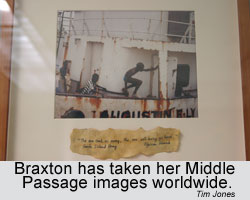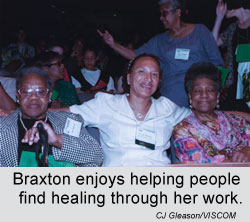Braxton exhibition casts light on the Middle Passage
During a research trip to Africa, Joanne Braxton, the College’s Cummings Professor of English, took photographs as visual reminders and notes for research on her performance piece Deep River. Upon her return, however, she found that the images conjured memories hundreds-of-years older than her recent journey—memories foreign to history books but familiar to many.
“When I saw the pictures, I realized that they tell a story, a very personal story that explores the problem of memory and the meaning of being an African American in ways that I had neither anticipated nor expected,” Braxton said.
 Knowing that the pictures had a potential purpose beyond her original
intent, the William and Mary English professor chose to share them
through the photo exhibit “African Odyssey: The Middle Passage
Remembered.” The display, currently featured at Lafayette High School as
part of its celebration of Black History Month, presents poetic
captions paired with faces and scenes from Ghana, Ivory Coast and
Senegal, West Africa. Since its creation in 2000, “African Odyssey” has
been displayed at several museums and as far away as Muenster, Germany.
Knowing that the pictures had a potential purpose beyond her original
intent, the William and Mary English professor chose to share them
through the photo exhibit “African Odyssey: The Middle Passage
Remembered.” The display, currently featured at Lafayette High School as
part of its celebration of Black History Month, presents poetic
captions paired with faces and scenes from Ghana, Ivory Coast and
Senegal, West Africa. Since its creation in 2000, “African Odyssey” has
been displayed at several museums and as far away as Muenster, Germany.
Although taken only six years ago, the photographs echo the troubled history of the trans-Atlantic slave trade—an event that many Americans have not yet come to terms with. Images are coupled with floating poetic captions scribed onto tea-stained paper with carefully burnt edges to signify tears or breaks in African diasporic memory, or what Braxton calls “sites of memory,” borrowing a term from French historian Pierre Nora.
“Sometimes we have kind of a collective or communal memory that has been passed down, sometimes through books, but often not, and we find ourselves asking questions that don’t seem to have answers. The answers are not really in the present, but in the past, so it’s like unraveling a tapestry and unraveling it in a way that healing can occur,” Braxton said.
 Stirring
depictions in “African Odyssey” begin to unwind the conflicts of the
Middle Passage. They serve to educate those unfamiliar with the global
diaspora and the impacts created by the trans-Atlantic slave trade. And
though the images are challenging in their reality, they are essential
to understanding the actual past of what was then the largest forced
migration in the history of the human race.
Stirring
depictions in “African Odyssey” begin to unwind the conflicts of the
Middle Passage. They serve to educate those unfamiliar with the global
diaspora and the impacts created by the trans-Atlantic slave trade. And
though the images are challenging in their reality, they are essential
to understanding the actual past of what was then the largest forced
migration in the history of the human race.
“When I talk about African diasporic memory, I’m speaking really of the written and unwritten history relating to various aspects of the slave trade as it touched five of the seven continents and thousands of islands all over the world,” Braxton said. “We as Americans are so consumed with guilt and shame with regard to chattel slavery in the United States that whenever anybody begins to speak about slavery, we immediately assume they are talking about us. But in reality, we’re talking about the Dutch, Swedes, Germans, French, the Spanish—everybody was getting what they could out of it. It was as much about human greed as anything else.”
Realizing that the slave trade’s effects permeate virtually the entire world is only part of the education Braxton hopes her exhibit will impart. She believes that “African Odyssey,” as it is shared with the community, can facilitate the processes of dialogue, reconciliation, and ultimately progress.
“My hope is that this exhibit will increase the understanding of the peoples and cultures of Africa and the diaspora, so that healing can take place, and new alliances can be forged,” Braxton said.
Lafayette High School is a meaningful place to offer the exhibit, Braxton said. Already familiar with the school, since her 14-year-old daughter is a sophomore there, she knew that gifted and talented teacher Lynda Dunnigan and history teacher Aaron Butler would use the exhibit to its fullest potential. Jamestown High School will host the “African Odyssey” exhibit during its 2005 Black History Month celebration, and the Middle Passage Project will help plan supporting activities.
“I felt some urgency about getting something that was positive and informative into the schools right away. So I thought, I’ll offer this to Mrs. Dunnigan, because she’ll know what to do with it and use it in a way that will benefit all students, not just a few,” Braxton said. The Middle Passage Project also provided Lafayette High School teachers with curricular materials from the “Voices in African American History” series from the Modern Curriculum Press.
Dunnigan too, feels the need for “African Odyssey” at the school, and has seized the opportunity, using the exhibit as the backdrop for an entire month’s worth of programming and SOL connections. “So often, people just pay lip service to Black History Month, but this exhibit gives us the time to really reflect. Sometimes we forget to truly celebrate who and what we are in terms of diversity,” Dunnigan said.
With Braxton’s exhibit lining the main hallways of the high school, students, teachers and community members have the entire month to embrace African American history. Butler, who was also instrumental in bringing Braxton’s exhibit to the school, said that the display’s presence gives depth to the coverage the Middle Passage receives in textbooks. “This really puts an image and a face to what we learn from our books—it brings to life what we see in the text,” he said.
It is education like this that ultimately promotes the kind of healing Braxton speaks of, and in turn, leads to opportunities for real progress. Providing the exhibit for Lafayette (and giving a guided tour for the community on Feb. 19) is not the first time Braxton has devoted herself to community involvement. As the director of the Middle Passage Project at the College, Braxton has been heavily involved in such outreach, both here and abroad, and she heavily thanks the College for enabling such opportunities. During the time she spent in Germany on a Fulbright professorship, she also gave numerous lectures in Germany, the Netherlands and France as well as doctoral seminars in Italy and Spain, usually for the governments of those countries, or high profile organizations, such as the John Adams House in Amsterdam and the Center for American Studies in Rome.
Throughout her career and particularly at William and Mary, Braxton, who is the senior black faculty member at the College in length of service, has been consistently committed to improving campus and community relationships and to building bridges of understanding. The path has not always been easy. From 1980 to 1985, she was the only black faculty member—not in her department, but on campus.
“It was an interesting time. I was fortunate to be able to participate in a number of searches, not only in my department, but also dean searches and affirmative action officer searches that ultimately made a difference,” she said.
In 1986 Braxton received the College’s Thomas Jefferson Teaching Award and in 1992, the SCHEV Outstanding Virginia Educator Award. In December 2003, Braxton delivered a paper recounting some of her struggles at a Modern Language Association meeting entitled “Teaching the Poetry of Langston Hughes on the Historically White Campus: My First Quarter Century.” This month, she gave a similar presentation, followed by a reading of Hughes’ poetry, for William and Mary students as part of the College’s own Black History Month celebration.
“This is a campus where gains have been made for both races. Here black women reign as Homecoming queens and white men are welcomed into the African American Male Coalition,” she said. “I would like to see mutual concerns aired in intellectually open and legitimate arenas, where new perspectives and fresh solutions can be explored. It is imperative that the understanding, cooperation and mutual respect that have become the hallmarks of interracial alliances on this campus be encouraged and not impeded. There is no turning back.”
 Skip to main content
Skip to main content
